
Alepidea is a genus of about 30 species in the family Apiaceae, all of which are endemic to Africa. They occur mainly in southern Africa, but can be found as far north as Ethiopia.
Anginon is a genus of flowering plant in the family Apiaceae. It is endemic to southern Africa.
Capnophyllum is a genus of flowering plant in the Apiaceae. It contains four species. They are endemic to southern Africa, particularly near the Cape of Good Hope.
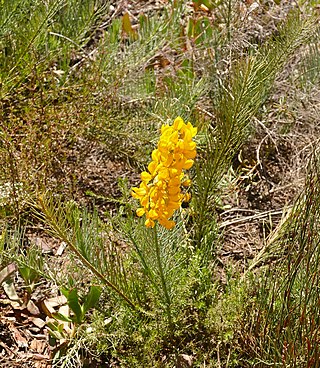
Lebeckia is a genus of plants in the family Fabaceae native to the fynbos of South Africa. Several members of Lebeckia were recently transferred to other genera. Members of Lebeckia are known to produce pyrrolizidine alkaloids, including ammodendrine, lebeckianine, and lupanine. The genus was named by Carl Thunberg for his student Heinrich Julius Lebeck.

Lotononis is a genus of flowering plants in the family Fabaceae and the tribe Crotalarieae. The genus includes 99 species of annual and perennial herbs, native to the southeastern Europe and Turkey, eastern Africa, and southern Africa.
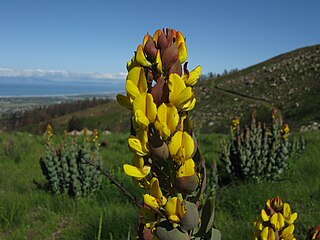
Rafnia is a genus of flowering plants in the family Fabaceae. It includes 29 species of shrubs and subshrubs native to South Africa. They grow in Mediterranean-climate fynbos (shrubland) and grassland, mostly on rocky and sandy soils. Most are native to the Cape Provinces, with some extending eastwards into KwaZulu-Natal. It belongs to subfamily Faboideae.

Stirtonanthus is a South African genus of flowering plants in the family Fabaceae. It includes three species of shrubs native to the Cape Provinces of South Africa. They grow in fynbos at medium to high elevations. Each species is highly localized. It belongs to subfamily Faboideae.
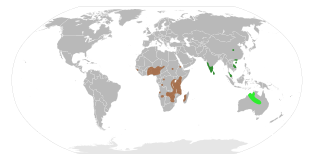
Rothia is a genus of flowering plants in the family Fabaceae. It belongs to the tribe Crotalarieae of subfamily Faboideae, and comprises two species:

Xiphotheca is a genus of flowering plants in the legume family, Fabaceae. It includes 10 species of shrubs endemic to the Cape Provinces of South Africa. They grow in fynbos, generally at medium or low elevations, and often species have highly localised ranges. The genus belongs to the subfamily Faboideae. The name of the genus is a compound of Ancient Greek ξίφος (ksíphos), which means "sword", and θήκη (thēkē) which can mean "box" or "sheath"—a reference to the shape of the legume pods. Members of this genus can be distinguished by:
"(1) the presence of bracteoles in most species; (2) the fusion of the bracts with the base of the pedicel; (3) the laterally compressed pods; and (4) the accumulation of anabasine as a major alkaloid."
Listia is a genus of flowering plants in the family Fabaceae and the tribe Crotalarieae. Members of this genus are mainly found in southern Africa but some species can be found in central Africa. It was recently segregated from the genus Lotononis. Unlike other members of the Crotalarieae, members of the genus Listia have lupinoid root nodules.
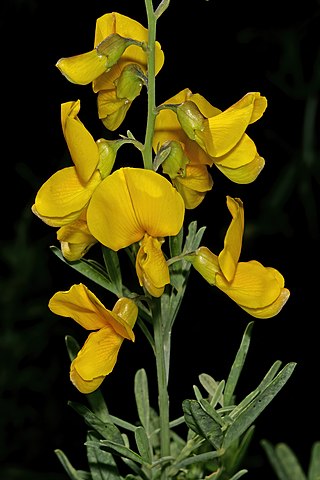
Calobota is a genus of flowering plants in the legume family, Fabaceae. It includes 16 species native to North Africa and southern Africa. It belongs to the subfamily Faboideae.
Wiborgiella is a genus of flowering plants in the family Fabaceae. It belongs to the subfamily Faboideae.
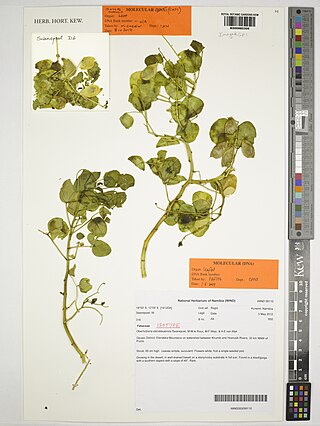
Oberholzeria is a monotypic genus of flowering plants in the legume family, Fabaceae. It only contains one known species, Oberholzeria etendekaensis which is endemic to Namibia. It belongs to the subfamily Faboideae, though its tribal affiliation is unclear.
Dasispermum are a genus of flowering plants in the family Apiaceae, native to coastal area of southern South Africa. Short-lived perennial or annuals, they are low-lying, often sprawling herbs with succulent or semi-succulent leaves, adapted to the dry, salty conditions of the littoral areas where they grow.
Cannaboides is a genus of flowering plants belonging to the family Apiaceae.
Pseudocannaboides is a genus of flowering plants belonging to the family Apiaceae.
Tana bojeriana is a species of flowering plant in the family Apiaceae, endemic to Madagascar. It is the only species in the monotypic genus Tana. The genus was first described in 1999, and the species was first described by John Gilbert Baker in 1890 as Peucedanum bojerianum.

Ben-Erik van Wyk FAAS is a South African professor of indigenous botany and traditional African medicine at the University of Johannesburg.









